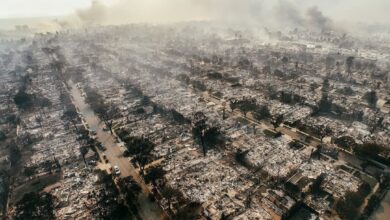Rebels Capture Damascus: Assad’s 24-Year Rule Faces Collapse as President Flees
Syrian rebels declared the capital city of Damascus "liberated" on Sunday after sweeping through the city with little resistance from regime forces.

Damascus, Syria — Syrian rebels declared the capital city of Damascus “liberated” on Sunday after sweeping through the city with little resistance from regime forces. In a dramatic announcement broadcast on state television, a rebel spokesperson claimed President Bashar al-Assad has fled, signaling the potential end of his family’s decades-long authoritarian rule.
“Damascus has been liberated, and the tyrant Bashar al-Assad has been overthrown. Oppressed prisoners in regime prisons have been released,” the spokesperson declared, flanked by rebel fighters. He urged civilians and combatants alike to protect property and emphasized inclusivity, stating, “Long live Syria, free for all Syrians of all sects.”
The fall of Damascus comes as the culmination of a lightning offensive by opposition forces that captured Aleppo last week and rapidly advanced across key regions of the country. Celebratory gunfire echoed through the capital as news of Assad’s retreat spread. Footage verified by press showed similar jubilant scenes in Aleppo and other cities.
A Decisive Shift in Power
The swift collapse of Assad’s government has upended the balance of power in Syria, a nation pivotal in the Middle East’s complex geopolitical landscape. Assad’s departure would mark the end of over 50 years of his family’s rule, initially established by his father, Hafez al-Assad.
Both Russia and Iran, staunch backers of the Assad regime, are now facing the prospect of a Syria governed by a coalition of rebel groups. The shift comes amid broader regional upheaval, with Iranian proxies Hezbollah and Hamas suffering significant setbacks in conflicts with Israel over the past year.
The United States is closely monitoring developments. National Security Council spokesperson Sean Savett said President Joe Biden and his advisers are in “constant touch with regional partners” to assess the unfolding situation.

Calls for Order Amid the Chaos
Prime Minister Mohammad Ghazi al-Jalali, one of the few regime officials to address the nation, expressed a willingness to work with the incoming leadership. “We are ready to cooperate with any leadership the people choose, offering all possible support to ensure a smooth and systematic transition,” he said in a recorded statement.
Al-Jalali urged Syrians to safeguard public facilities, while Ahmed al-Sharaa, also known as Abu Mohammad al-Jolani, leader of the rebel faction Hayat Tahrir al-Sham (HTS), issued strict orders to respect state institutions. “It is strictly forbidden to approach public institutions…and it is also forbidden to fire bullets into the air,” he announced via Telegram.
The rebels also claimed control of the notorious Saydnaya Military Prison, freeing scores of detainees.
A Historic Turning Point
The fall of Damascus echoes the early days of the Arab Spring, when peaceful protests in 2011 against Assad’s rule devolved into a protracted civil war. Over 12 years, the conflict has devastated Syria, claiming hundreds of thousands of lives and displacing millions.
As jubilant crowds dismantled Assad’s portraits in liberated areas, scenes harkened back to the protests of 2011, when Syrians first took to the streets demanding freedom.
For now, the future of Syria remains uncertain, with calls for unity and reconstruction competing against the challenges of governing a deeply divided nation.





